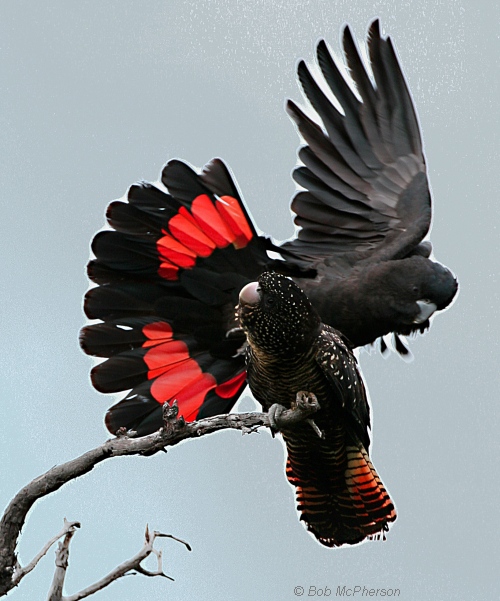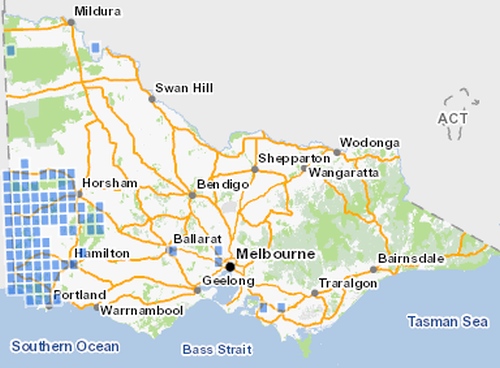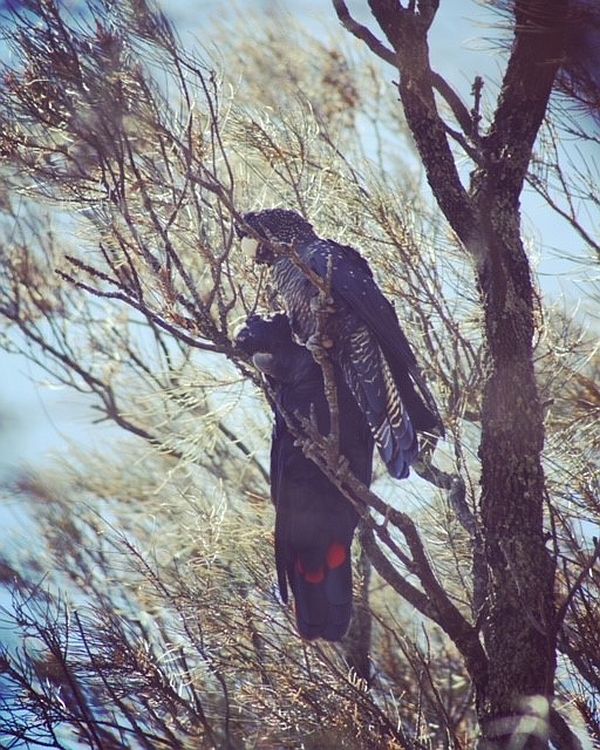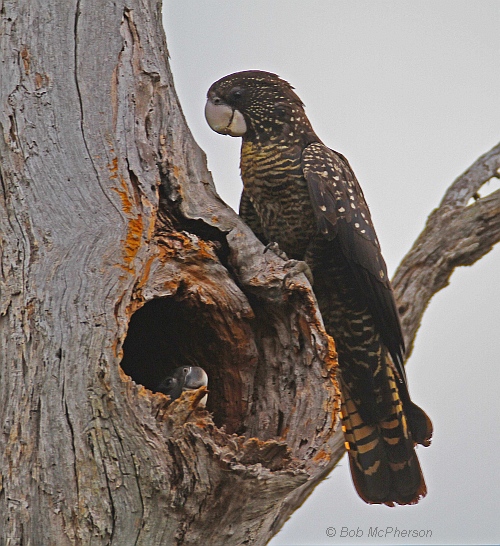45 images of Red-tailed Black Cockatoos: They’re pretty awesome with their golden dots and tail feathers up to 63cm
South-eastern Red-tailed Black-Cockatoo
Calyptorhynchus banksii graptogyne
Kingdom:Animalia
Phylum:Chordat
Class:Aves
Order:Psittaciformes
Family:Cacatuidae
Status
Australia:Endangered EPBC Act
Victoria:Endangered (DELWP 2022)
FFG:Listed; Action statement No. 37

Red-tailed Black-Cockatoos Male (rear) and female (perched);note barring on tail.
The Red-tailed Black-CockatooCalyptorhynchus banksii is a large dark grey-black cockatoo up to 63cm in length. Its genus name Calyptorhynchus is derived from the Greek words calyptos – hidden – and rhynchus – beak.
It has a rounded crest and a large bill; males have a dark bill and an obvious red tail band whilst females have fine yellow spots on the head and wings with yellow barring across the breast. Females also have a more yellow-orange-red barred tail band and a creamy coloured bill. Juveniles have similar markings to females and a duskier coloured bill.
Five distinct subspecies are recognised in Australia, with considerable variations in overall size, bill shape, bill size and colour between each of the races.
Calyptorhynchus banksii subspecies
- Calyptorhynchus banksii graptogyne – south-west Victoria and south-east of South Australia.
- Calyptorhynchus banksii banksii – northern and eastern Queensland.
- Calyptorhynchus banksii macrorhynchus – northern Western Australia, Northern Territory and Gulf of Carpentaria.
- Calyptorhynchus banksii samueli – Inland Australia from western side of Western Australia, Central Australia and patchy through the Murray-Darling area in western New South Wales.
- Calyptorhynchus banksii naso – south-west corner of Western Australia.
Calyptorhynchus banksii graptogyne is smaller in overall body size than other subspecies. It also has the lowest population and is restricted to the south-west of Victoria and adjacent areas in the south-east of South Australia. The population in 1996 was estimated to be not more than 1000 with only a small proportion (10%) or 100 breeding pairs (Emison 1996), In 2002 the highest count was 785 birds (Commonwealth of Aust. 2007). In 2015 the population was estimated to be around 1500 individuals. The 2016 count was 901 birds. Monitoring of flock counts in 2016 also found that either no young from the past three years have survived to join flocks or that there has been an increase in the death rates of adult females (Red-tail newsletter Issue 43 November 2016). Monitoring of flocks in 2017 found an increase in the number of barred birds compared with 2016 which indicates there could have been some successful nesting the previous year but in the 2018 the numbers of barred birds were down indicating there has been very little successful breeding over the past three years.
Distribution

Ecology & Habitat
The south-eastern Red-tailed Black-Cockatoo inhabits Brown Stringybark Eucalyptus baxteri woodlands (Heathy Woodland EVC) as well as River Red Gum Eucalyptus camaldulensis, Yellow Gum Eucalyptus leucoxylon, Swamp Gum Eucalyptus ovata, Buloke Allocasuarina luehmannii, Drooping Sheaoak Allocasuarina verticillata and occasional patches of Pink Gum Eucalyptus fasciculosa.
Different habitats are used for feeding, nesting and roosting; feeding areas of Heathy Woodland EVC are mostly within state forests and parks reserves whilst Buloke feeding areas and nesting habitat with Red Gum associated EVCs are predominantly on private land (Joseph 1991, Venn 1993, RFA 2000, Maron 2005). Approximately 68% of roosting habitat is located on private land with Red Gums being the most utilised trees (Commonwealth of Australia 2005).
Feeding
Diet of the south-eastern Red-tailed Black-Cockatoo is specialised, consisting of seeds from the Brown Stringybark Eucalyptus baxteri as the primary source of food. During late summer or early autumn seeds from Bulokes Allocasuarina luehmannii become an important source of highly nutritious food.
Understorey communities can substantially influence habitat productivity. Stringybark communities dominated by large grass-trees (Xanthorrhoea australis) have substantially lower capsule density, while communities dominated by bracken have substantially higher capsule density (RTRBC Issue 48 April 2019).
Buloke trees in paddocks in the southern Wimmera have been identified as providing critical feeding habitat in this area (Maron 2005) and Buloke dominated woodlands of this region are nationally endangered under the EPBC Act 1999 (DEH 2000). Buloke seed is only available during January to March and the Red-tailed Black-Cockatoo only forages in large mature trees greater than 19cm dbh (diameter at breast height) which are estimated between 100 years to 200 years old. They prefer trees over 200 years old (Maron and Lill 2004). Different trees are used in different years with the most valuable trees being large, with large cone crops and close to other Bulokes (Loyn et al. 2007).

A pair of Red-tailed Black-cockatoos feeding in a Buloke tree. (male left; female right) note barring on the females tail feathers. Image courtesy Sky McPherson, RTBC Recovery Team.
Nesting
The south-eastern Red-tailed Black-Cockatoo uses large hollows (15-50 cm) which occur mostly in very old, large eucalypts. A six year study of nesting between 1988-1994 found a low incidence of nesting with only 16 nests being the highest number recorded in any one year. Nesting has only been recorded in the northern half of the range. Hollows in River Red Gums Eucalyptus camaldulensis provide the most favoured habitat for nesting, with 90% of recorded nest sites being located on private farmland. Of these 85% were found in dead, usually ring barked, trees (Emison 1996).
Nests are more likely to be close to the cockatoo’s stringybark feeding habitat which can change from year to year which also explains why it is uncommon for pairs to use the same nest each year as they move about their range in search of food and new nest hollows.
Although Red-tails can return to the same breeding areas in different years and in some cases even return to nest in the same paddock, they don’t necessarily use the same tree.

Tree hollows are needed for Red-tailed Black-Cockatoo nesting